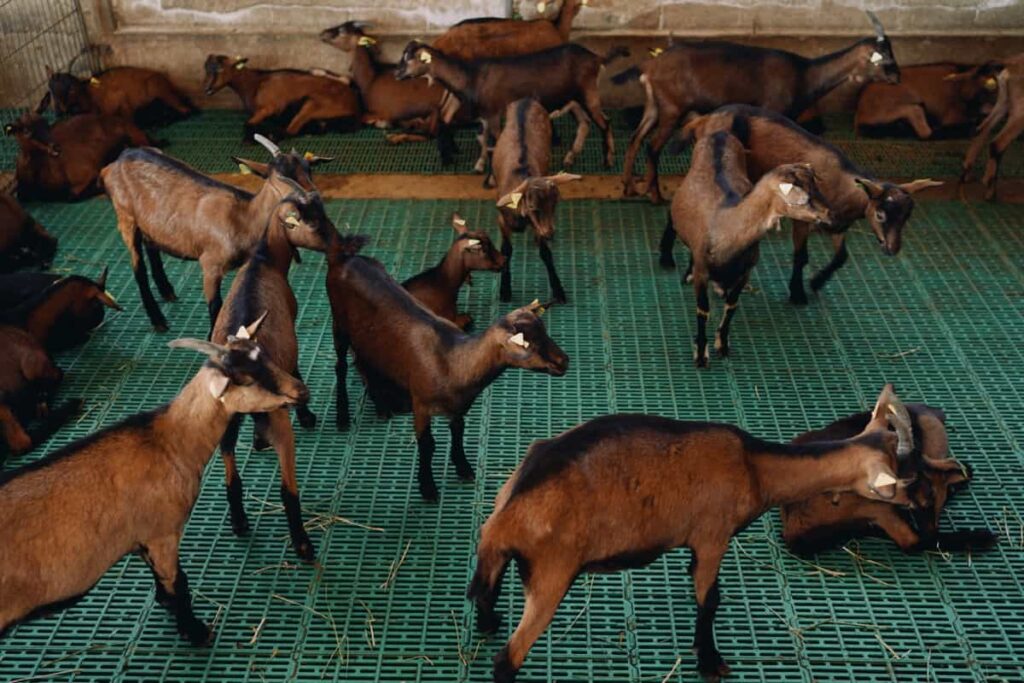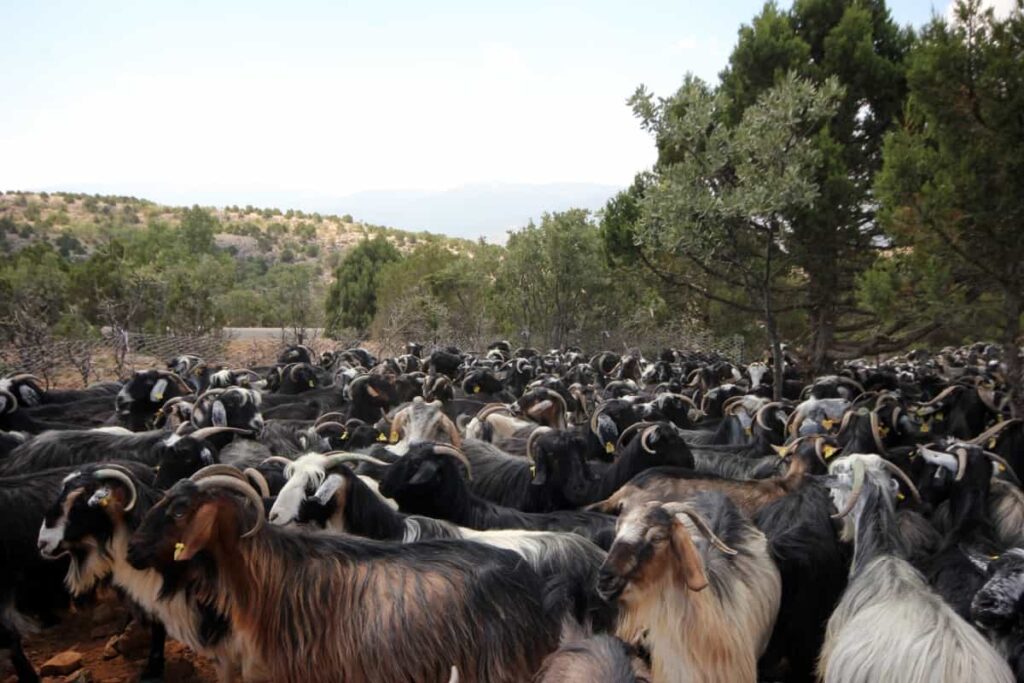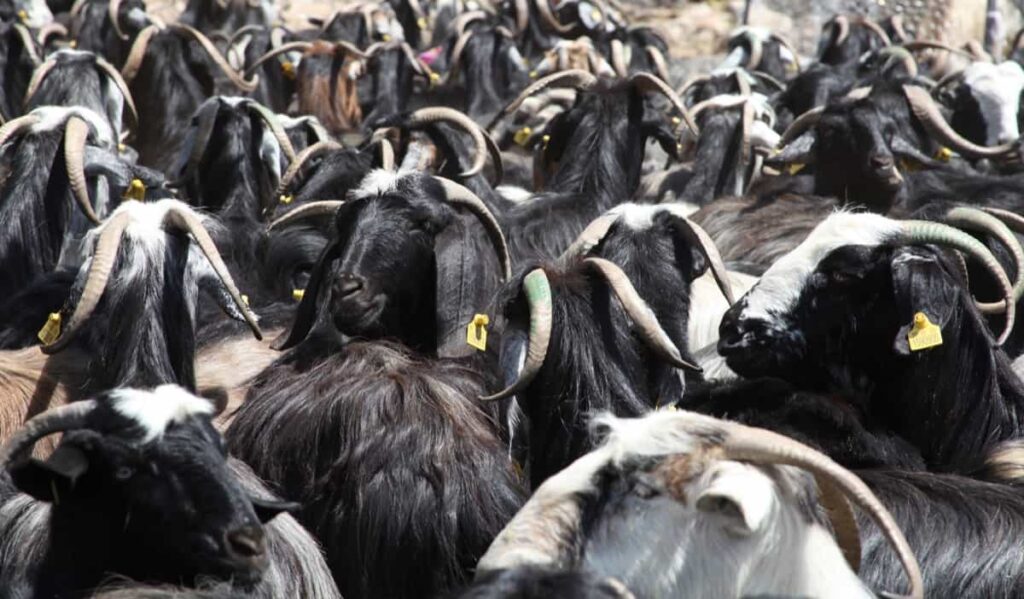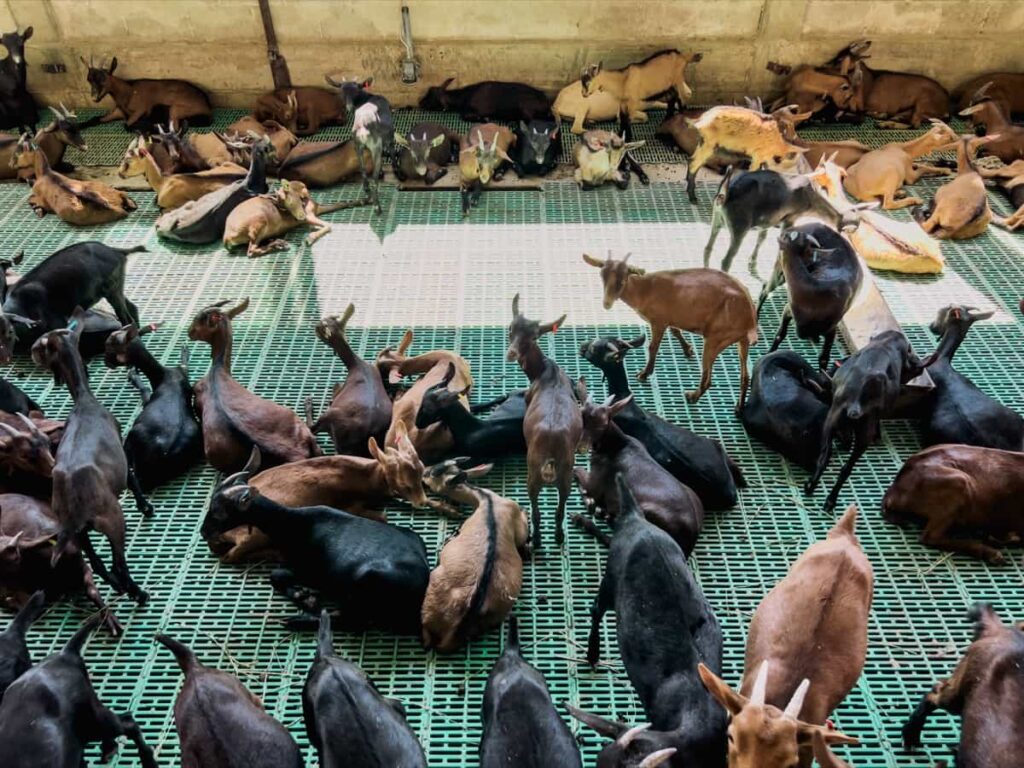Discover Telangana’s thriving goat farming landscape: a comprehensive overview of prevalent breeds, current trends, and pivotal government policies and support systems shaping this dynamic sector, presented in a clear, concise format.

Telangana Goat Farming
An Overview of the Industry’s Current Status
In Telangana, goat farming has grown a lot in the last few years. Because the state has a lot of different landscapes and good weather, it has become a center for raising goats. The government of Telangana has been supporting goat farming through a number of different programs and plans. Farmers are now more interested because of these attempts. The Boer breed is highly sought after for producing meat because it is of such high quality.
Crossbreeding projects have also become popular as a way to get more done. Goat meat, which is called “chevon,” is very popular all over the world. Farmers’ incomes have gone up because there are more chances to export goods. Problems like controlling diseases and getting enough food still exist, but these problems are being worked on all the time through study and development.
Different Breeds of Goats Found in Telangana and Their Characteristics
Osmanabadi Goat: Osmanabadi goats are a prominent breed in Telangana. They are medium-sized and known for their adaptability to the region’s climate. These goats have a strong and sturdy build, making them suitable for various purposes, including meat and milk production. Their coat is typically black or brown.
Jamunapari Goat: Jamunapari goats are recognized for their large size and distinctive appearance. They have a white coat and long, drooping ears. These goats are primarily raised for milk production, and their milk is rich in fat content.
Black Bengal Goat: Black Bengal goats are small in size and have a glossy black coat. They are known for their hardiness and resistance to various diseases. These goats are primarily raised for meat production.
In case you missed it: Bengal Gram Farming in Telangana: Varieties of Chickpea/Bengal Gram in Telangana

Sirohi Goat: Sirohi goats are medium-sized and have a reddish-brown coat. They are well-suited for both meat and milk production. Their milk is of good quality and contains a moderate fat percentage.
Boer Goat: Boer goats are large-sized goats with a distinctive white body and a reddish-brown head. They are raised for meat production and bestknown for their fast growth rate.
Government Policies and Support for Goat Farming in Telangana
Livestock Insurance Scheme for Goat Farming
The Livestock Insurance Scheme provides coverage for goats against natural disasters, diseases, accidents, and theft. Premium rates are 3% for annual policies and 4.5% for three-year policies. The sum assured is Rs. 3000 per goat, with subsidies of 50% for small and marginal farmers and 25% for others.
Telangana State Sheep and Goat Development Cooperative Federation Ltd.
This state-level body offers services like subsidized breeding stock, feed, medicines, and vaccinations. It organizes health and training programs, facilitates marketing, and implements government-funded projects for sheep and goat development.
Financial Assistance and Incentives Provided by the Government
NABARD Subsidy for Goat Farming
(National Bank for Agriculture and Rural Development) offers subsidies under the Animal Husbandry Infrastructure Development Fund (AHIDF) for goat farming. Subsidies range from 25% to 35% of the project cost, benefiting various categories of beneficiaries. The subsidy is disbursed after project completion and initial loan repayment.
Role of Telangana State Agricultural University in Developing and Improving Goat Farming Practices
Goat Research Station in Warangal: This facility researches goat production areas like breeding, nutrition, health, management, and economics. It has developed pure breeds like Jamunapari, Osmanabadi, Black Bengal, and their crossbreeds. It offers farmers high-quality breeding goats at low costs.
Krishi Vigyan Kendra (KVK) in Adilabad: KVK trains farmers in advanced goat farming techniques, introducing them to improved breeds like Sirohi and Boer. It organizes educational trips, health camps, and vaccination drives.
Technological Innovations: PJTSAU has introduced various technologies to boost goat farming. This includes the urea-molasses mineral block (UMMB) for better feed utilization, fodder banks for consistent fodder supply, Azolla cultivation for protein supplementation, vermicomposting of goat manure, comfortable goat sheds, goat insurance, and added value to goat products.
Challenges Faced by Goat Farmers in Telangana and How the Government is Addressing Them
Goat farming is a vital means of making a living in Telangana, India, especially when the weather is bad. India has about 1.08 crore goats, which is 6.4% of its total animal population. Goat farming has problems like limited access to good breeding, shrinking grazing lands, poor medical services, and limited ways to sell goats. To deal with these problems, the government of Telangana has set up the Telangana State Sheep & Goat Development Cooperative Federation (TSSGDCF), which helps with everything from selling to getting money.
In case you missed it: Growing Potatoes Organically in Telangana: Step-by-Step Cultivation and Production

The NABARD goat farming loan plan also provides cash aid for different farming needs. Farmers can go through training programs that cover important topics like choosing the right breed and avoiding getting diseases. Research and development work is also being done at places like PVNR Telangana Veterinary University, with the main goals of improving breeds and making vaccines. The goal of these projects is to make goat farming in Telangana more productive and profitable so that the business can continue to grow.
Impact of Climate Change on Goat Farming in Telangana and Adaptation Strategies
Climate change has a big impact on goat farming in Telangana. Rising temperatures and unpredictable rain patterns make it hard for goats to get water and make them sick from the heat. This lowers the number of bucks born, lowers the amount of milk produced, and makes people more likely to get sick.
To deal with these problems, farms are using better house designs to keep animals cooler, water-saving methods, and rotating feeding to make good use of pasturelands. Adding medical care and using goat types that can handle the heat are also important steps. The goal of these steps is to keep goat farming going in Telangana so that people can still make a living even though the weather is changing.
Market Trends and Opportunities for Goat Farmers in Telangana
Goat farming is a good way to make money in Telangana because people are eating more meat, and the government has programs to help farmers. The area’s good weather and wide range of goat types, such as Osmanabadi and Boer, make output more efficient. Also, programs like the Telangana Sheep Distribution Scheme help local goat farming by giving money and medical care.
The market also benefits from a strong demand for goat meat in the area and across the country, which is helped by the possibility of exporting the meat. Small-scale farmers are also interested in goat farming because it requires little money to start up, and goats are very fertile. All of these things make goat farming in Telangana a good business for farmers.
Collaboration between Farmers, Government, and Private Sector to Boost Goat Farming in Telangana
The Amul Dairy Cooperative in Gujarat is implementing a scheme to empower rural women and small farmers in Telangana. The project aims to provide quality goat breeds, health care, insurance, and market linkages to the beneficiaries. The project is based on the model of Amul Dairy Cooperative in Gujarat, which has transformed the lives of millions of milk producers. The project consists of three main components: goat breed improvement, goat health care, and goat marketing.
It will provide subsidized goat breeds, establish breeding centers, and train local women as Pashu Sakhis (animal friends). The project is expected to benefit about 1.5 lakh goat farmers in 31 districts of Telangana, generate employment chances for rural youth and women, and contribute to the state’s economy and food security by enhancing the production and consumption of goat meat and milk.
Future Prospects and Sustainability
Goat farming in Telangana has significant potential due to the enhanced demand for goat meat and dairy products. Laws that support businesses, such as funding and training programs, make this growth possible. Goats are also popular with farmers because they can live in a variety of conditions and don’t need much care. Using current farming methods can make farming more productive and last longer. Goat farming in the area has a bright future thanks to efforts to be more eco-friendly and grow the market, including by offering export possibilities.
In case you missed it: Growing Spinach Organically in Telangana: Cultivation Practices and Production Guide

Frequently Asked Questions (FAQ) on Telangana Goat Farming
How Can Technology Be Used to Improve Goat Farming in Telangana?
Technology like livestock management software, automated feeding, and health monitoring systems can significantly improve efficiency and productivity.
What Role Do Women Play in Goat Farming in Telangana?
Women play a crucial role, often being primary caretakers of goats, and are integral to small-scale goat farming operations.
Conclusion
Telangana’s goat farming shows robust growth, leveraging local breeds like Osmanabadi and Boer. It significantly improves rural livelihoods and boosts the state’s agricultural economy, thanks to government initiatives like subsidies and veterinary care.
- Profitable Village Farming Business Ideas in 2024
- High-Yield Aquaculture: Fast-Growing Fish for Farming
- Effective Fish Pond Construction Techniques for Beginners
- Irrigation and Water Management in Pineapple Farming
- Blossom to Harvest: Mastering Flowering and Pollination in Papaya Farming
- Pig Fattening Essentials: From Selection to Sale for Beginners
- Raising Wagyu Cattle: A Complete Guide for Premium Beef Production
- Soil Types and Their Water Holding Capacity
- Optimizing Irrigation Schedules for Coconut Groves for Enhanced Yield
